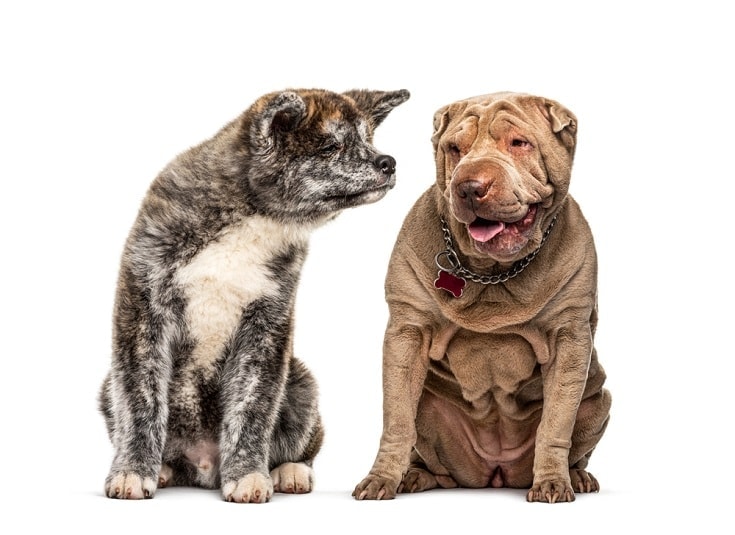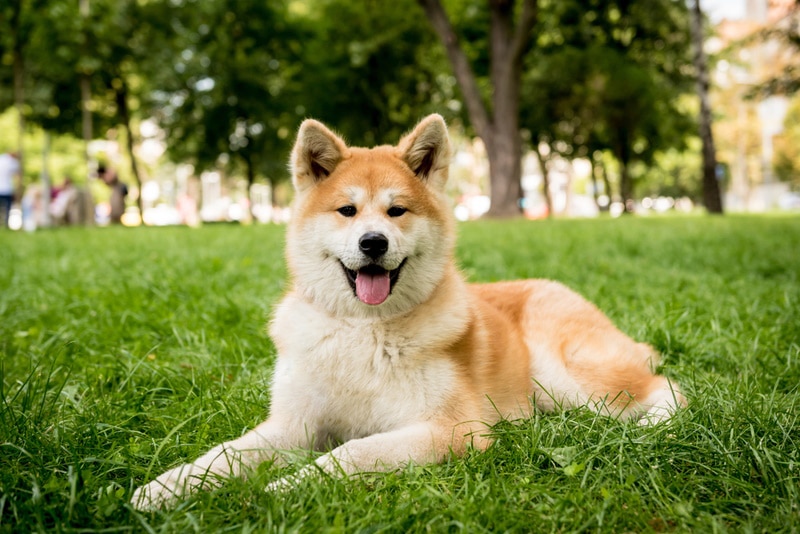Are Akitas Good with Other Dogs? Introduction Tips & FAQ
By Hanh Duong
Updated on

The Akita is a powerful dog with a long history in Japan. They are renowned for their honor, fearlessness, and dedication. These canines are one of the best family protectors and are a representation of long life, happiness, and good health in their native land. If you already have other dogs in the house but are considering adopting an Akita, the question of whether Akitas get along with other dogs is probably one of your top concerns.
Most Akitas prefer to be the only pet in the family and can be aggressive toward other dogs, particularly those of the same gender. If properly socialized, these canines can be taught to tolerate other animals, but they will almost certainly attempt to maintain their dominance. The following information is crucial if you’re thinking about getting an Akita and have other dogs already.
Akita Temperament
Generally, Akitas have a bold, alert, and protective temperament. They are sweet and affectionate family members but are suspicious of strangers and tend to keep a distance. Usually, they will grow up to be calm, confident, and mature dogs. Due to the independence and strength of Akitas, they are generally not suitable for families with older people, children, or other pets. Despite their intelligence, they are not always eager for training sessions and following your instructions. These dogs have a very strong-willed nature. In addition, with the dedication to protecting their family, they may easily misunderstand some of your friend’s normal behavior as a threat, which could lead to overprotectiveness.
It can be very challenging to understand and raise an Akita. Compared to many other breeds, they exhibit more “primitive” thought patterns and behaviors. Their facial expressions or body language are also more subtle, making them difficult to read and understand, especially for inexperienced owners. Note that these are generalizations about the breed, and each Akita may behave differently.

Are Akitas Aggressive?
Akitas have an aggressive gene that can be challenging or even impossible to change 1. Their attitude can shift from playful to hostile in a minute. Therefore, you should never leave young children or other animals with an Akita alone without supervision. Take your strong-willed dog to an obedience training class to learn how to curb their aggressive nature and create a safer living environment. You must learn how to become the leader of your Akita and how to hold that position.
Do Akitas Have a High Prey Drive?
Due to their strong prey drive, Akitas may pursue any smaller animals that enter their territory. Therefore, you should never let your dog run free around small pets like rabbits, guinea pigs, mice, gerbils, ferrets, and birds unsupervised.
Tips for Introducing an Akita to Another Dog
1. Make an Introduction in a Neutral Area
The best place for dogs to get to know one another is a neutral outdoor space. Each person involved should have a different canine on a leash. Don’t forget to bring a bag of tasty treats they love. Start by separating the dogs at a distance so that they can see each other without being overly agitated. Give them treats if they are not exhibiting any undesirable behaviors. For instance, you could say, “Good boy!” in a cheerful, friendly voice and reward him when he looks at the other dog without a reaction. Repeat this process a few times.

2. Pay Attention to How Each Dog Is Acting
Keep an eye out for body language that suggests a defensive or wary reaction, such as teeth-baring, hair standing up on the back, growling, a prolonged stare, or a stiff-legged gait. If you notice these postures, whether they are far apart or close to one another, calmly and quickly break the interaction by engaging them in something else. Conversely, you can close the gap between the dogs if they seem comfortable and happy. Again, whenever the dogs look at each other peacefully, give them treats.
3. Delegate the Pace of the Introduction to the Dogs
By the halfway point of the stroll, the dogs might want to play with one another. It’s also possible that it will take a little more time before they feel secure enough to walk side by side. The most crucial thing is to take this introduction slowly. The chances of success will increase as your level of patience increases, so avoid pressuring the canines to interact.
Allow one dog to follow the other while they are close enough to see each other, and then switch. You can let them walk side by side if they feel comfortable doing so. Finally, encourage the canines to interact but remember to always keep a close eye on them. Introduce them more gradually if either one or both exhibit any signs of agitation or stress.

Conclusion
Unfortunately, Akitas in general don’t get along well with other dogs. As a result of their assertiveness and dominance, the breed can be quite aggressive with other canines, particularly those of the same gender. With extensive early socialization and the proper training, though, you can absolutely make Akitas a little more dog-friendly. However, it’s still not a guarantee that they can live peacefully with other canines. So, it’s probably best not to have other animals in the house if you want to adopt one of these pups.
Featured Image Credit: Eric Isselee, Shutterstock











